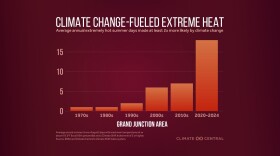-
A new report finds that rising temperatures are making droughts across the Mountain West and Southwest even worse — and longer-lasting.
-
A new scientific analysis shows that fall temperatures are rising across the country because of climate change, especially in the Mountain West. More than simply a delay in sweater weather, experts say this trend has more serious impacts.
-
How can plant-rich eating help save the planet?
-
More hot days and more smoky days are affecting our children's health now and in the future.
-
Next week, Boise's Climate Action Team will be hitting the streets to try and figure out which parts of the Treasure Valley are the hottest.
-
The organizations delivered a letter to the National Governors Association, which meets this week in Colorado Springs, Colo.
-
It’s Friday, which means it's time for our Reporter Roundtable when Idaho Matters gets you up to date on all the news that made headlines this past week, including the latest on the threats to public lands and the expansion of a Valley County mine.
-
A new analysis shows that climate change is causing the number of extremely hot summer days to rise in most major U.S. cities. Some of the biggest increases are in the Mountain West.
-
A home insurance crisis faces Mountain West states as wildfires blaze the region.
-
Each year our society produces an overwhelming amount of plastic waste, contributing to a pollution crisis that not only impacts our environment but our health.

Play Live Radio
Next Up:
0:00
0:00
Available On Air Stations











